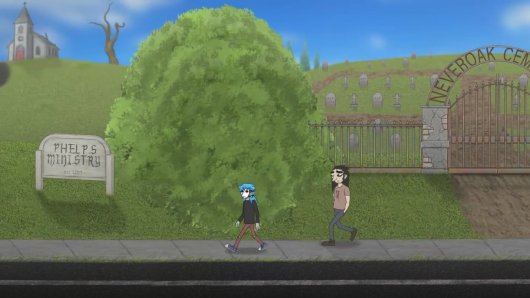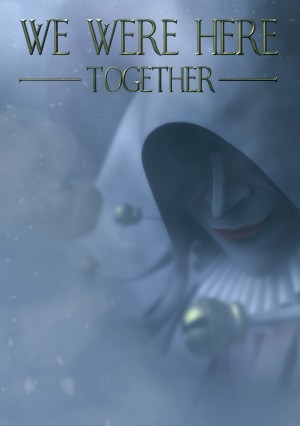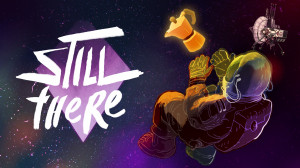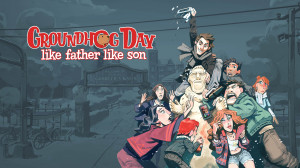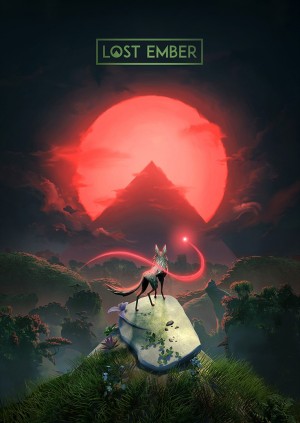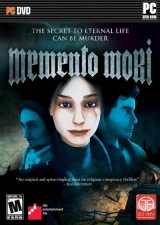Review for Sally Face

Game information
Sally Face doesn't lend itself to easy categorization. Begun in 2016 and now finally complete three years later, this five-part episodic series started out as a fairly straightforward story of a young boy in a new town but ends with dimension-hopping, necromancy, body-sharing, and the slaying of eldritch beasts through the power of electric guitar. I’ve spent a long time trying to find a way to accurately describe the full Sally Face experience, and the conclusion I've come to is that language, as a concept, just hasn't gotten there yet. Imagine the dreams you'd have after watching Evil Dead 2 on repeat while consuming only candy and Red Bull. Imagine snapping out of anesthesia at a Buckethead concert and then reading Lovecraft for the first time. Imagine...well, imagine whatever you want, really—it's still not going to come close. This is a gorgeous, inventive, overstuffed, unique, frustrating, delightful adventure game. It's certainly the only one of its kind you’re likely to play in this reality.
The story opens with a disturbing dream sequence: a young boy wanders through abandoned hallways, his face obscured by bloody bandages, while visions from his past appear to admonish him for his sins. He arrives at a hospital bed containing a woman's corpse, and then it ends. We soon learn that the dreamer is one Sal Fisher, a prison inmate who's been describing the nightmares to his court-appointed therapist. At the doctor's prompting, Sal turns to the topic of his childhood, and thus begins a years-long tale of murder, cannibalism, the occult, heavy metal, and the power of friendship.
Due to its original episodic release, the game unfolds over the course of five discrete acts. In the first we meet Sal as a boy, while he and his father are in the process of moving into a new apartment in the town of Nockfell. Sal doesn't have high hopes for the new town, as he's not used to being treated nicely. A mysterious incident left him disfigured as a young child, and the mask he wears to cover up his scars led bullies to derisively dub him "Sally Face." (Not wanting to let them have the upper hand, Sal “reclaimed” the nickname for himself.) Shortly after moving into Addison Apartments, he makes his first real friend in Larry, a teenaged metalhead who lives in the basement with his mother, the resident handywoman. Larry tells Sal about the building's many strange tenants and warns him that Nockfell is decidedly not like other small towns: strange things tend to happen here, including demonic apparitions and frequent disappearances, and many of them are centered on the complex. Case in point: there's recently been a murder in Addison, and Larry thinks he knows the culprit. When Sal agrees to help him prove it to the authorities, the two find themselves drawn into a much larger world of cults, ghosts, monsters, and supernatural plagues...among other things.
Each act represents a different period of Sal’s life in Nockfell; as the game progresses we see him and those around him growing older, with many small details from early installments receiving follow-ups in later ones. Along the way the protagonist’s circle of friends grows to include Todd, a tech-whiz who talks like he reads the dictionary for fun, and Ashley, a kind-hearted artist with a taste for mystery, while Larry remains his best bud and a constant in his life. As the gang deals with the mysteries of Nockfell—including a sudden rash of ghost sightings, a schoolteacher's dark secret, and strange changes in their neighbors' behavior, to name a few—they learn of a sinister organization called "the Devourers of God," which they begin to suspect has much more than their little town in its sights. Hanging over all of this, of course, is the question of why exactly the adult Sal is in prison, and whether the stories he's telling (first to his therapist, then to a reporter, and finally in the courtroom) are even true…
The more Sal and company uncover, the deeper you’ll understand the rabbit hole goes, until you find yourself dealing with transdimensional beings, parallel realities, multiple afterlives, and evil doppelgangers. There's more going on in Sally Face than any review could ever hope to summarize, to the point that I sometimes felt in danger of losing track. With so many plot threads in play by the end—not to mention a constant stream of new information about the game's strange alien cosmology—it becomes a struggle to keep all the hows and whys straight. This is further complicated by the fact that, while you’ll play as Sal for the vast majority of the game, you’re occasionally given control of other characters, which sometimes makes it difficult to remember who was where at what time, and what they did there.
There's also a truly staggering amount of hidden content, including diary entries, mysterious videotapes, unlockable minigames, and entire optional areas featuring additional character moments and story insights. These shine a much-needed light on the more esoteric aspects of the plot, and having to actively engage with the world to see everything it could offer made me feel like a more active participant. Still, many of these secrets are very secret, to the point that I often only realized I'd missed something hours after the opportunity had passed. This would be fine if the missable bits were just fun bonus material, but many of them have a bearing on later plot developments—regardless of whether you actually found them. This means the story can become unintentionally muddled, as when a character cites an interaction from a previous act as a reason for switching allegiances; as you can easily bypass that earlier conversation without ever learning about it, this moment will be incomprehensible to players who never found it.
These issues might easily have proved fatal if the game ever slowed down enough for you to consider them in depth, but Sally Face presents such a captivating world to explore and fills it with so much imaginative energy that you'll be hard-pressed not to fall under its spell. Every moment is packed with things to do, see, and find: from start to finish you'll have the feeling that anything could happen around the next corner, and that your understanding of how everything fits together is only ever a screen or two away from being upended. Most games give you a solid sense of what they will and won't be in their early moments, allowing you to acclimate to their worlds and understand what will be asked of you, but figuring out exactly what Sally Face is going to become next is as much of an adventure as the game itself.
Just when you think you're playing a fairly traditional puzzle-solving adventure, along comes a ghost-detection mechanic that also unlocks a top-down, tile-based minigame, and when it seems like that's the last trick the game has up its sleeve, you’re confronted with a rhythm-based matching sequence where you play guitar to open arcane seals. There's a segment that mimics a side-scroller, a bit of beat-em-up-style combat, a stealth sequence, and on and on, all leading to a reality-bending final chapter so elaborately and audaciously staged that I couldn’t help exclaiming "Oh, no way!" when it arrived. Most impressively, none of these sequences ever feel like they’re just there for novelty’s sake or because the developer wanted to show off; they all feel like organic parts of Sal’s story, and having played through I can’t imagine the game working without them. (It’s possible to die in a few of these segments, but in each case you’re immediately zapped back to when they started.)
None of which is to say that Sally Face isn’t still an adventure game at its core. For the majority of its approximately 15-hour playtime you’ll travel from room to room, collecting inventory items and talking to other characters while you piece together puzzle solutions; there are more of the inventory- and dialogue-based variety than of the “find the symbol corresponding to the power chord that will blow up the tentacle beast’s eye” type. A few puzzles don’t work as well as others: there’s one involving a clock whose solution I simply had to look up, and which I still don’t understand even with the answer in hand, and there’s a tedious maze sequence that—as near as I can tell—one solves simply by wandering around until you don’t have to anymore. Apart from those, however, the obstacles are generally well-integrated.
For the most part the keyboard or gamepad controls are simple. They’ll change in some of the wilder sequences but the game will tell you what’s different when they do. Most of the time the screen lacks a Y-axis, so you’ll only ever move left and right, and a single button allows you to interact with hotspots when prompted by the object line. A second opens the inventory, and examining the items you’ve acquired will bring up a description (and, if next to a relevant hotspot, a prompt to use the object in the environment.)
Unfortunately—and at times quite frustratingly—some hotspots are never identified as such, meaning important objects often appear as simple window dressing until you press Interact when standing next to them (as I only discovered when I’d exhausted every other idea that occurred to me while searching for a particular item). No rationale is provided for this, and I couldn’t find any rhyme or reason as to which objects were deserving of identification and which weren’t. Interacting with innocuous-looking background details makes sense as a method for unlocking secrets—and that’s how you’ll find quite a few of them—but this same issue cropped up in a number of unskippable puzzles. You’ll get into the habit of pressing the interact button without prompting once you realize that doing so is necessary to progress, but it still feels like an artificial attempt to make the game seem more challenging.
The vast and vibrant world is Sally Face’s greatest strength, as just about every individual aspect of its presentation works to make Nockfell feel alive. The hand-drawn visual style, with its fuzzy, fluctuating lines and colored-pencil shading, makes you feel as if you’ve been transported into the world of a talented metalhead’s classroom doodles. This somewhat simple appearance belies a surprising amount of versatility, and the animation features some wonderfully gruesome flourishes, like the ghosts who appear one layer at a time—first blood, then meat, then skin. The aesthetic frequently changes when the gameplay does, as with the pixelated greyscale graphics on Sal’s “Gear Boy” game system. (The biggest visual surprises are saved for the end, and I wouldn’t spoil those for the world.)
The soundtrack, too, shows a great deal of range, varying from ominous synth in dream sequences, to early-2000s-flavored electric guitar in the halls of the Addison building, to headbanging metal tracks when Sal and Larry hang out. It perfectly captures the paradoxical blend of melancholy, longing and up-tempo enthusiasm playing on constant repeat in a teenage dreamer's head. The script similarly acknowledges what it feels like to be a young person looking for their place in a scary, hostile world, and how wonderfully transformative it can be for a lonely kid to finally find people who understand them. Despite its macabre trappings, the prevailing attitude throughout the game is one of compassion, even for some of its ostensible villains.
There are moments, however, when it feels like the understanding, no-judgements-here tone stretches a bit too far, as when an otherwise-sympathetic character justifies a series of incredibly shocking acts by arguing that the supernatural consequences of doing otherwise would have been much worse. This may be entirely correct within the context of the game, of course, but it seems like the action moves on far too quickly afterward, with the “right” and “wrong” of the situation treated immediately as given. The writing doesn’t do nearly enough work to show the player why what just happened was necessary, and for me the game wobbled a bit afterward as I tried to regain my equilibrium. (It should be noted that Sally Face includes a great deal of graphic violence, including numerous murders, very detailed depictions of cannibalism, and more than one on-screen suicide. It might be about kids, but it's definitely not for them.)
It's hard to know where to stop when talking about Sally Face. There will always be more to say, just as there's always more to find in Nockfell. Incredibly, everything in the game—visuals, soundtrack, writing, programming—is the work of a single person, developer Steve Gabry. The result is an intensely personal vision, one that I doubt could be replicated or even approached by a AAA studio with unlimited budget. Much like Sal himself, it's creative, inventive, and unafraid to fly in the face of what people expect if that means being true to itself. There's really nothing else like Sally Face. It isn't perfect, but make no mistake—it's an experience you'll never, ever forget.
WHERE CAN I DOWNLOAD Sally Face
Sally Face is available at:
- GOG -33%
- Itch.io
- HumbleBundle






